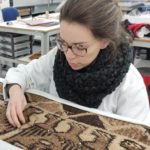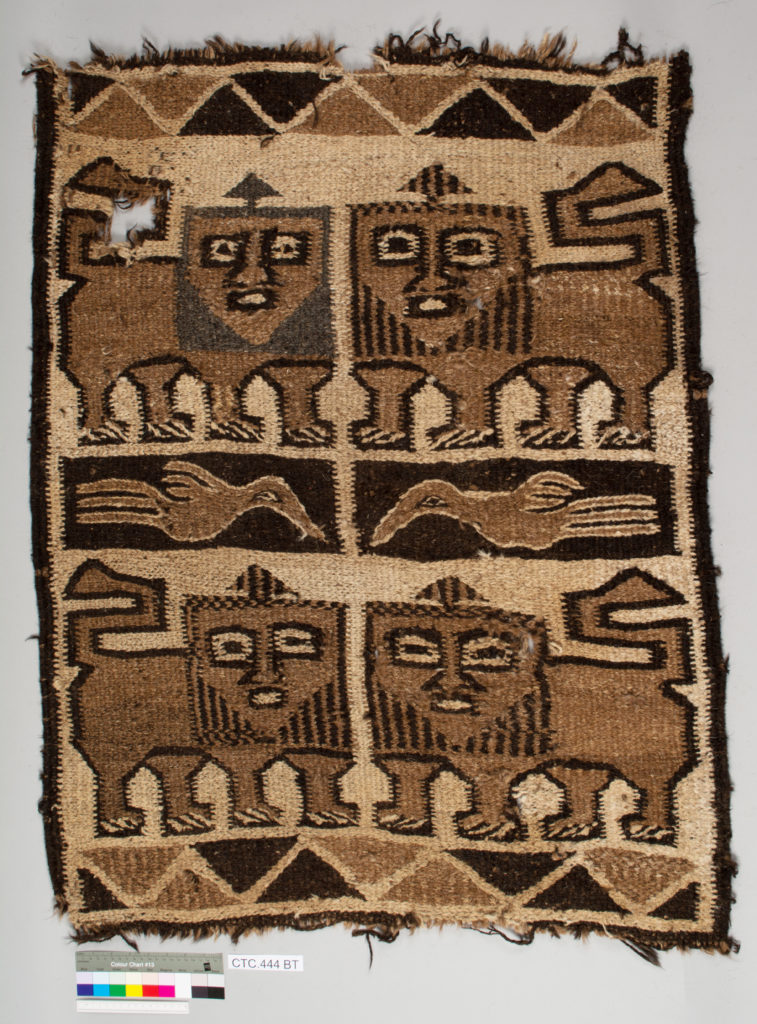
by Marina Herriges, 2nd year student, MPhil Textile Conservation
During the second year of the programme, students are given more complex objects to be treated. In my case, I received an exciting surprise – an Ethiopian rug! This was a very pleasant challenge for me, as I am quite keen on flat textiles, especially tapestries, which made me feel enthusiastic about treating this object. However, this rug had a unique characteristic regarding its woven structure, which guided my treatment in a slightly different way, providing me with self-confidence as an emerging textile conservator, as well as broader challenges, such as time management and organization skills.
In fact, I first received two rugs, both from Ethiopia with similar iconographies: lions of Judah. These Ethiopian rugs belong to a private client and not much information was known about them. According to the literature, the lion of Judah represents the emperor Haile Selassie I (1892-1975) whose empire lasted from 1930 to 1974.[1]
Both objects were extensively documented as a first approach. This was the initial opportunity to learn and develop my skills regarding documentation of a slightly bigger object and match my proposal with the available work schedule. The technique of construction is called weft twining in which ‘two wefts pass across warps, twisting together after each warp.’[2] This would be one of the points which impacted the treatment approach.

The aim of the treatment was to stabilize one of the rugs to be displayed in a domestic context. Due to the strong smell of the fibres (probably camel hair) and moth infestation, the rugs were previously washed using a household detergent and frozen by the client to destroy any pests to prevent further damage. At the time that the rugs came to me, the fibres were in very poor condition as they were easily broken, even with gentle handling. After testing, the fibres presented high alkalinity (pH9.0), which in the case of wool/hair fibres had led to the weakening of the fibre, resulting in a brittle and fragile material.

As a result, a beneficial part of the treatment was wet cleaning using a conservation detergent to decrease the alkalinity of the fibres as well as to remove remaining soiling. This was a successful step of the treatment, as the fibres were more stable and less brittle afterwards.

Next, the stitching support treatment was started. My initial approach was treating the rug using the same methodology applied in tapestry conservation:[3] The support was carried out through a scoured linen fabric in order to provide stability for the rug as a whole. However, at the time of stitching, I was faced with the unfortunate visual impact that a traditional brick couching technique would give to the rug. This was a moment that a pause for reflection on the treatment proposed was crucial for the success of the further steps. The chance to stop and re-evaluate my proposal as well as speak with experienced conservators were key to the development of my observation skills and a unique way to learn from the vast experience of other professionals. Due to the twining weave structure, the stitching needed to be slightly altered in order to match the structure and reduce the visual impact. It was a process of self-trust: following my intuition about what I thought would work and giving it a go! Finally, the technique worked perfectly!

Currently, the stitching has
been completed, and the next step is to speak with the client as an opportunity
to discuss possible displays for the rug for its long-term preservation.
This project has been an excellent experience to
develop my skills as an emerging textile conservator, as well as to enhance my
organization and timing skills. These broader aspects will also be useful in
managing my future work schedules: I have already been given another object to
be treated besides the Ethiopian rug. Busy and exciting times are coming up!
[1] ‘Haile Selassie I – God of the Black race,’ BBC Religions, accessed November 2, 2019, https://www.bbc.co.uk/religion/religions/rastafari/beliefs/haileselassie.shtml
[2] Peter F. Stone. Oriental Rugs: an illustrated lexicon of motifs, materials and origins. (North Clarendon: Tuttle Publishing, 2013), 305.
[3] Karen Finch. 1994. ‘The history and development of tapestry conservation’ Paper presented at The Misled Eye: Reconstruction and Camouflage Techniques in Tapestry Conservation. (Amsterdan: TRON, 1994) 45-58.


A beautiful rug. It is always interesting when « standard » conservation stitches, such as laid couching or, as mentioned above, a brick couching technique, are not adapted to the construction or weave of an object and adaptations or other stitching solutions have to be found. It’s therefore a shame that there is no image, photo or diagram, to illustrate the « altered » stitch that Marina used for the consolidation of the rug and that in her own words « worked perfectly «. Would it be possible to publish one?
Thank you for this. I have 2 modern flag rugs brought back from Ethiopia.
Found out last weekend that the Moth was at them. Feel very fortunate to have found an open dry cleaners whose owner is a trained tailor originally from Iran.
She knows how these rugs are made and is not only cleaning them, but also reweaving the hole for me.
I recently purchased a couple Ethiopian rugs, and as you mentioned the smell from the animal hair is very strong! I was going to wash them with a household detergent, like your client, but not sure if that would harm the rugs. Any thoughts on how I could wash them and preserve the quality?